Intensity versus consistency in training, which is more important? The #1 rule for becoming a better athlete is consistency. Hands down!! Nothing else comes close. Champions in all walks of life are built from many years of practice. Getting to the top of any endurance sport takes time and patience. Alistair Brownlee won a gold medal at the London 2012 triathlon at the age of 24. That’s very young for triathlon, but he had been completing high-volume training since his early teens (over 10 years). In fact, if you start with your end goal and work out what training you will need to achieve that goal, you can then rewind to today’s date and ask yourself, “What do I need to do to ensure that I complete as much of that training and practice as possible to achieve my goal?”
The answer is very simple.
Turn up – for every workout, every physio session – and don’t get injured, don’t get ill.
This statement might have some of you scratching your heads and thinking, “Well, that’s easy for full-time athletes but I have a job and a family.” But, it’s quite simple. In the next few paragraphs, I’ll outline some of the common mistakes age group athletes make, and how you too can become world-class with your training consistency.
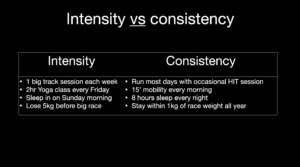
Some examples of intensity versus consistency
Be realistic
How much training can you really manage over the long term? Look back at your training diary and look at your average weekly volume for the past few years. That will give you a very good idea. Unless you retire early or win the lottery, I’d wager that this total won’t change a great deal. Why? Because you’ll still have the same weekly commitments. Most people’s lives just don’t change that much. If you are in a high-pressure job now, chances are you’ll still be in something similar in 5 or 10 years’ time and that will impact how much time you can devote to training.
Think long-term
The reason most athletes overdo their training is that they’re in a hurry to make improvements or prepare for a race. Big changes in your physiology take years to achieve. Sure, you’ll hear of some individuals making huge gains in a short period. But dig deeper and you’ll most likely find out some other truths. Like they used to be a teen prodigy, lost their way, and then returned to the sport. If you try to chase a big goal in a short time frame almost inevitably, you’ll get injured or ill. If you think long-term, then you only have to make small gains consistently. And because the pressure is off, you’ll be more relaxed while you’re doing it.
Build slowly
Most coaches talk about increasing training load by less than 10% on a regular basis, and athletes like to think they can stretch this further. After all, if you’re running 30’ today, adding 10% means just 3 minutes extra in the next run. Or if you run 2 hours this week, then next week it will be 2 hours 12 minutes. But if you did that every week, in just 10 weeks you’ll be running 4 hours 40 minutes. That’s probably too big a leap. If you took a year to build to that volume, then you could add just 3 minutes per week, which is less sexy but way more manageable. Are you starting to see the difference between intensity versus consistency?
No hero workouts
C’mon, you might as well admit to this. We’ve all done it! In my world the big hero session every bank holiday is 100 x 100 in the pool. Not many swimmers managed it but those who did were smashed for the next few days. I’d guess that no one swam the next day. Similarly, 40 x 400 on the track or a big day in the saddle. Occasionally it’s fine, especially if you’re planning to have some easy days or time off afterward. But in the world of aiming for a long-term goal, it’s important to avoid these sessions as much as you can. Generally, they don’t do as much to your fitness (although they might help build your mental toughness). More likely though, they will leave you so fatigued that you can’t make the sessions the next day and maybe the day after.
So much for your consistency. You’d have been better doing 30 x 100 on consecutive days, as that would have been much easier to recover from and your long-term feel for the water would have benefited more from 3 sessions versus just one.
Don’t get sore
The idea that soreness is a good thing seems to originate from the body-building world. In fact, these days anyone who goes to the gym seems to try and create ‘the burn’ in every workout so the session can be viewed as a success. The trouble with this is that if you do 10 sets of squats, the simple act of walking, never mind running, will be difficult for the next few days. With time the body adapts, and subsequent sessions don’t create the same soreness but nevertheless, there will be some.
Typically, triathletes don’t spend quite as much time in the gym, but it’s just as easy to get sore from a hard run or long bike session. Track sessions and runs with lots of downhill have the potential to create a lot of soreness, which will impact your next run session. And while you are resting up, your rivals will be continuing with their run sessions and building their consistency.
Sleep
Ignore this at your peril. More training requires more sleep. Most recreational athletes don’t get enough. You may think that sleep tracking gadgets are a bit of a gimmick, but they do create real behavioural change for the better. If you are going to do everything to avoid missing training, you should also apply the same rules to your sleep. What can you do to make sure you get what you need EVERY NIGHT?!
Nutrition
This is part of your training. It’s not difficult. Regardless of your nutrition philosophy plan ahead, buy real food, prepare your own meals, and make sure you get enough of all the macronutrients. And yes, this includes carbohydrates. Finally, the two things just about all experts are aligned with: Reduce your intake of refined sugars and processed foods! Hydration is also part of this equation so make sure you stay on top of your individual requirements.
If we roll up the points above into guidance for a long-term training programme it will look something like this:
- Follow a polarised approach most of the year using a 90:10 or even 95:5
- Easy/moderate training will build mitochondria, and the occasional HIT or HIRT workout will help those mitochondria to work more efficiently
- Add a small amount each week to your endurance workouts
- Maximise your weekly volume before adding intervals (this is Seiler’s first principle – see graph below)
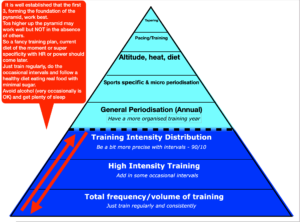
This pyramid by Stephen Seiler illustrates very nicely the most important elements of training
- Add 1 rep more each week to your HIT workouts. Remember that if you start with just 5 reps and add 1 per week, you’ll be up to 20 steps within 4 months. That’s BIG progress!
- Apply a similar principle to your strength work. If you did 10 reps last month and 15 reps this month then you are getting stronger.
- Pay attention to the elements that help you to recover from training – sleep, nutrition, mobility. All the training in the world will have limited effect unless you become a master of these.
To find out more about Simon’s coaching services, please click here. To purchase Simon’s e-book, How to be a High Performance Human, please click here.



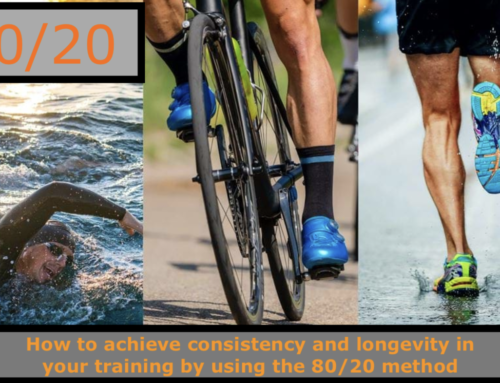

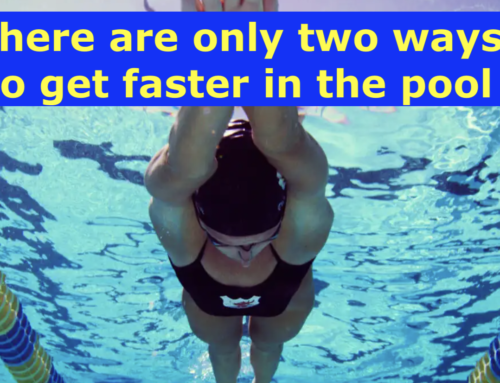
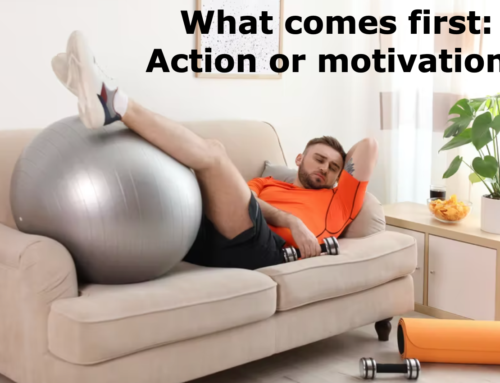
Leave A Comment